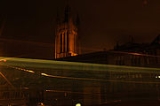
Long exposure photography
Encyclopedia
Long-exposure photography or time-exposure photography involves using a long-duration shutter speed
to sharply capture the stationary elements of images while blurring, smearing, or obscuring the moving elements.
Long exposures are easiest to accomplish in low-light conditions, but can be done in brighter light using neutral density filter
s or specially designed cameras.

In this technique, a scene is kept very dark and the photographer or an assistant takes a light source—it can be small penlight—and moves it about in patterns. The light source can be turned off between strokes. Often, stationary objects in the scene are illuminated by briefly turning on studio lights, by one or more flashes from a strobe light
, or by increasing the aperture
.
between 19 December 2007 and 21 June 2008. Part of the Slow light: 6 months over Bristol exhibition, Quinnell describes the piece as capturing "a period of time beyond what we can perceive with our own vision." This method of solargraphy uses a simple pinhole camera
securely fixed in a position which won't be disturbed. Quinnel constructed his camera from an empty drink can with a 0.25mm aperture and a single sheet of photographic paper
.
Shutter speed
In photography, shutter speed is a common term used to discuss exposure time, the effective length of time a camera's shutter is open....
to sharply capture the stationary elements of images while blurring, smearing, or obscuring the moving elements.
Technique
When a scene includes both stationary and moving subjects (for example, a fixed street and moving cars or a camera within a car showing a fixed dashboard and moving scenery), a slow shutter speed can cause interesting effects, such as light trails.Long exposures are easiest to accomplish in low-light conditions, but can be done in brighter light using neutral density filter
Neutral density filter
In photography and optics, a neutral density filter or ND filter can be a colorless or grey filter. An ideal neutral density filter reduces and/or modifies intensity of all wavelengths or colors of light equally, giving no changes in hue of color rendition.The purpose of standard photographic...
s or specially designed cameras.
Night photography
Long-exposure photography is often used in a night-time setting in order to produce a near daytime effect in the photo. By leaving the camera's shutter open for an extended period of time, more light is absorbed, creating a brighter product. If the camera is stationary for the entire period of time that the shutter is open, a very vibrant and clear photograph can be produced.Light painting

In this technique, a scene is kept very dark and the photographer or an assistant takes a light source—it can be small penlight—and moves it about in patterns. The light source can be turned off between strokes. Often, stationary objects in the scene are illuminated by briefly turning on studio lights, by one or more flashes from a strobe light
Flash (photography)
A flash is a device used in photography producing a flash of artificial light at a color temperature of about 5500 K to help illuminate a scene. A major purpose of a flash is to illuminate a dark scene. Other uses are capturing quickly moving objects or changing the quality of light...
, or by increasing the aperture
Aperture
In optics, an aperture is a hole or an opening through which light travels. More specifically, the aperture of an optical system is the opening that determines the cone angle of a bundle of rays that come to a focus in the image plane. The aperture determines how collimated the admitted rays are,...
.
Water and long exposure
Long exposures can blur moving water so it has mist-like qualities while keeping stationary objects like land and structures sharp.Solargraphy
A solargraph is a long-exposure photograph which shows the path taken by the sun across the sky. One example of this is a single six-month exposure taken by photographer Justin Quinnell, showing sun-trails over Clifton Suspension BridgeClifton Suspension Bridge
Brunel died in 1859, without seeing the completion of the bridge. Brunel's colleagues in the Institution of Civil Engineers felt that completion of the Bridge would be a fitting memorial, and started to raise new funds...
between 19 December 2007 and 21 June 2008. Part of the Slow light: 6 months over Bristol exhibition, Quinnell describes the piece as capturing "a period of time beyond what we can perceive with our own vision." This method of solargraphy uses a simple pinhole camera
Pinhole camera
A pinhole camera is a simple camera without a lens and with a single small aperture – effectively a light-proof box with a small hole in one side. Light from a scene passes through this single point and projects an inverted image on the opposite side of the box...
securely fixed in a position which won't be disturbed. Quinnel constructed his camera from an empty drink can with a 0.25mm aperture and a single sheet of photographic paper
Photographic paper
Photographic paper is paper coated with light-sensitive chemicals, used for making photographic prints.Photographic paper is exposed to light in a controlled manner, either by placing a negative in contact with the paper directly to produce a contact print, by using an enlarger in order to create a...
.

